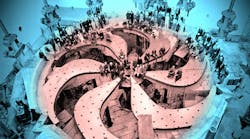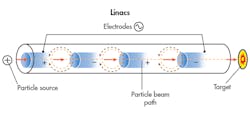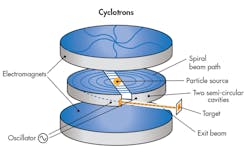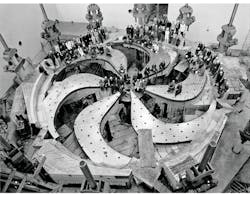What are the Differences Between Linear Accelerators, Cyclotrons, and Synchrotrons?
This file type includes high resolution graphics and schematics when applicable.
Linear accelerators (also called linacs), cyclotrons, and synchrotrons are some of the most complex and expensive tools ever built. In general, their purpose is to accelerate charged particles, usually electrons, protons, and isotopes, as well as subatomic particles, to incredibly high speeds. The particles are used to treat tumors or cancers inside patients, slam into material samples (or beams traveling the opposite direction at similar speeds for even higher-energy reactions) to determine the makeup of the material based on the reactions and scattering of particles after the impact, to create isotopes that will be used for medical or industrial purposes, and to generate strong X-rays and other forms of light used for material science and biology. The accelerators are also used to boost the speed of particles so they can be injected into other accelerators and taken to higher speeds and kinetic energies.
Linear Accelerators
As their name suggests, linacs accelerate particles in a straight line. The particles, which are usually electrons, protons, and ions, travel in a pipe-shaped vacuum chamber. Electrodes inside the pipe are spaced so that a driving radio frequency can be timed to energize them as particles are in the gap between electrodes, and thereby accelerate them as they travel from one gap to another. For high-power linacs, each electrodes has its own RF source.
The first linac was built in 1928, and they can be as small as a cathode ray tube (a form of linac) or as large as the Stanford Linear Accelerator (SLAC), which at one time measured 2 miles long and could accelerate electrons up to a speed at which they have the kinetic energy of 50 billion eV. (By definition, an eV equals the amount of energy gained or lost by the charge of an electron moving across an electric potential difference of one volt. So 1 eV equals approximately 1.6022 x 10-19 joules, or 1.6022 x10-12 ergs.)
Linacs can accelerate heavy ions to speeds not possible with ring-type accelerators (cyclotrons and synchrotrons), because they are limited by the strength of the magnetic fields needed to keep the ions on their curved path. Linacs are also better for sending electrons up to relativistic speeds because electrons lose energy (and speed) through radiation when they travel along an arc. But linacs require lots of real estate, making them costly to build.
Cyclotrons
Unlike linacs, cyclotrons accelerate particles along an outward spiral path and are held in that path by a static electromagnetic field perpendicular to the spiral path. Charged particles get injected into the center of the cyclotron into a vacuum chamber between two hollow D-shaped metal electrodes (called “dees”). An alternating RF voltage of several thousand volts is applied to one dee and then the other. The timing of the RF voltage is switched between dees, accelerating the particles and increasing the diameter of their circular path with every revolution, turning it into a spiral.
When the particles reach the rim of the dees, they leave them through a small gap and are guided toward a target. Hitting the target can create nuclear reactions, and particles from that reaction may be guided into various instruments for analysis.
For several decades after the first ones were built beginning in 1934, cyclotrons were the best source of high-energy particle beams useful in nuclear physics. They were invented by Ernest Lawrence, who earned a Nobel Prize in physics for his work. The beams they produce are well suited for producing isotopes used in nuclear medicine. There are 1,200 cyclotrons around the world that are used to create radionuclides for medical purposes. Cyclotron beams are also used to penetrate patients’ bodies to kill tumors with minimal harm to the person. The beams are also used in PET imaging.
The largest cyclotron ever built was a 184-in. diameter version competed in 1946 at UC Berkeley; it accelerated protons to 730 MeV.
Synchrotrons
Synchrotrons, like cyclotrons, are cyclic accelerators and send particles into a closed-loop path, increasing their speed with each revolution. But unlike cyclotrons, the synchrotron’s loop is not a spiral. In fact, since the various tasks a synchrotron must accomplish—focusing, bending, and accelerating the particles into a beam inside a vacuum pipe—can be accomplished by different assemblies and at different times, the path can be a circle, oval or a polygon with rounded corners.
The task for accelerating the beam is handled by radiofrequency cavities spaced around the loop. An RF power generator supplies an electromagnetic field to the specially molded and shaped cavity that converts the ERF power into electromagnetic waves that become resonant and build up inside the cavity. When the charge particles enter the cavity, the force and direction of the resulting electromagnetic field accelerates them along the loop.
One drawback of synchrotrons is they cannot accelerate protons for other particles from standstill; they must already be moving, a task handled by another accelerator. For example, the Large Hadron Collider (LHC), the world’s largest synchrotron with a 17-mile circumference, takes in particles already at 450 GeV, sends them around the 17-mile path 14 million times in 20 minutes, and then researchers have a 6.5 TeV beam.
With particles always circling the accelerator, researchers can send beams through each other repeatedly, creating a large number of collisions, events that could potentially reveal the building blocks of the universe. In experiments, the LHC reached 400 million collisions per second, which creates lots of data to study. While the LHC works primarily with proton beams, it can also accelerate heavy nuclei such as lead. And other synchrotrons are designed to work with a variety of different particles including uranium and gold ions.







